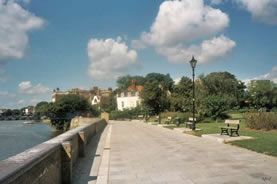‘Super Sewer’ Proposals Will Continue To Be Challenged
Council leaders warn "never underestimate the power of public opinion"
At a well-attended meeting organised by Hammersmith and Hounslow Councils last night, Richard Aylard of Thames Water reassured residents that Ravenscourt Park had "never been considered" as the starting point for the Super Sewer.
He explained that it was more than 500 metres from the river and the bridges carrying the District and Piccadilly lines offered an obstacle to the transport of spoil to the river for disposal by barges.
In addition Furnival Gardens was "not big enough for the entrance of a drilling shaft". The only construction envisaged there would be to connect the existing sewer overflow opposite the Dove Pier to the Super Sewer. This site would be the size of half a football pitch and work would last for two years. When it was finished the only visible sign would be a new manhole cover in a three metre diameter concrete disk.
However he cautioned several times that Thames Water had " no preconceived ideas for drilling sites" and that he "could not rule out any site" in the eventual project. Thames was looking with the riparian boroughs to find, ideally, brownfield sites within 500 metres of the river, with good transport links for the movement of machines and materials. Thames Water had been instructed by the Government to "get on" with developing this project in consultation with others.
Hammersmith and Hounslow Councils, who are acting together, are calling for an independent study to look at all aspects of the Thames Water scheme and to see if there might be better solutions with less impact at less cost.
There were four expert speakers: Dave Wardle from the Environment Agency, Mr Aylard of Thames Water, Andrew Wetnall from the Consumer Council for Water, and Raj Bhatia, president of the Stamford Brook Residents Association. Mr Wardle considered the water quality issues stemming from the slow discharge of water from the Thames. When there is no rain, it can take 2-3 months for landwater to finally reach the sea after ebbing and flooding with the tides, because the Thames basin is so flat.
Although the quality of the Thames has improved immensely since the 1950s, with 40 resident species of fish, there is still room for improvement to reach EU standards. Scum and floatsam make the river unsightly and bacterial contamination is high after heavy rainfall and a resulting sewage discharge. The same problem affects all major cities in the UK and they are all spending large sums to deal with it.
Andrew Wetnall took a sceptical view of the cost-benefit claims for the project. The cost was estimated at the beginning of 2007 at £1.5bn, later £2.5bn, and now it was " £1.3bn by 2015" with another 5 years of construction work to go.
The technical difficulties were likely to worsen: in the chalk layer where the east portion of the tunnel would be drilled there are flints the size of footballs which will disrupt and delay drilling, and the chalk will sometimes need to be frozen to prevent flooding.
It is not clear who will bear the financial risk of delay in drilling beyond the estimated 8 years, although he suspected a proportion would be left to the customers of Thames Water. If water bills went up to £400 per year 50-60% of poorer families in some boroughs simply could not pay, and would be pushed into "child poverty", defined as spending 3-4% of income on water bills. Funding issues are extremely pertinent in the present economic conditions, and it was not clear what the cost of capital would eventually be. He was not impressed by PFI schemes. He advised looking at alternative smaller schemes which would not lock us into one particular and very expensive solution.
The agreed increases in capacity at London's largest sewage works would go a long way to improve matters. Ofwat advised in 2007 that "the benefits will be very limited and not proportional to the very high cost. Climate change will erode the benefits within 60 years." Finally the EU Waste Water Directive requires countries, not just the residents of London, to use "best technical knowledge not entailing excessive cost" to carry out improvements to water quality. If it came to a court case would the European Court of Justice oblige us to aim so high?
Raj Bhatia raised asked why there needed to be six access shafts, rather than just two, one at each end. Stephen Walker, Projects director for Thames Water who had overseen the construction of the London Ring Main and brought it in under budget and on time, replied that for safety reasons there needed to be escape routes from the single tunnel in case of fire.
Perhaps surprisingly Mr Walker admitted that, to date, the "level of engineering detail is minimal" for this project, because, he said, Thames Water were consulting widely. This struck some in the audience as showing a lack of preparation for a project comparable only to the Channel Tunnel.
Peter Thompson of Hounslow and Stephen Greenhalgh of Hammersmith Councils wound up the meeting, after questions, by encouraging everyone to write their views on the form given out at the meeting, saying that one should "never underestimate the power of public opinion".
Una Hodgkins
November 18, 2008
Related links
|
